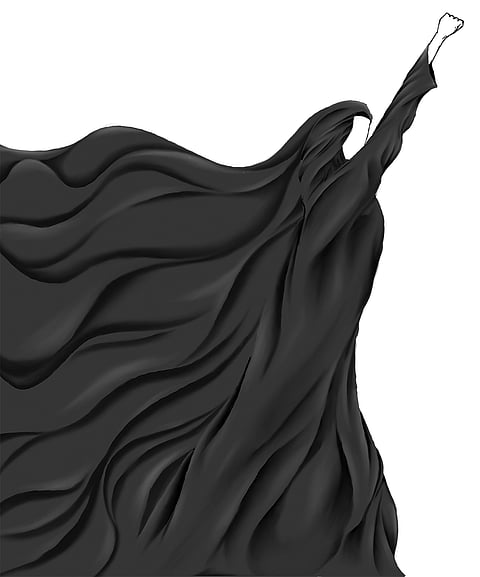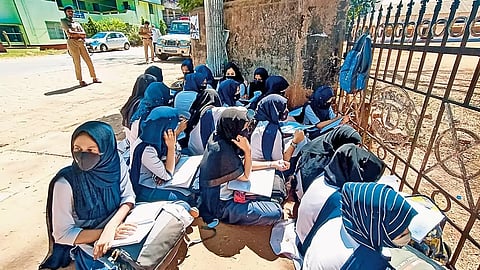19-year-old Aliya Assadi from Udupi has lost a year of her education. Several of her female peers have dropped out entirely or are forced to study remotely. In December 2021, Assadi was one among six young women of the Government Pre-University (PU) College for Girls in Udupi, Karnataka, who had been barred from sitting for their examinations simply because they had refused to remove their hijabs (head-covering) before entering the classroom.
The Hijab Row In Karnataka: One Year Later
The hijab ban may not be an election issue this time but the polarisation it has created between Hindus and Muslims in parts of Karnataka is here to stay.
Images of the six hijab-clad young women sitting on the staircase in a non-violent defiance of the no-hijab rule quickly flew through the internet and television. In the days that followed, the women vocally defended their right to wear clothes of their choosing, with Assadi being one of the first petitioners to move the Karnataka High Court seeking the protection of the right of Muslim girls to wear the hijab in educational institutions. Today, over a year later, the ‘hijab ban’ remains in place. Assadi is finally preparing to appear for the examination that she had been barred from attending, but this time, from a private institution instead. “I will be wearing the hijab,” she says.
Young Muslim women in Karnataka are caught in the crosshairs of the legal justice system, right wing organisations and religious fundamentalism, all of which have impacted their personal freedoms, autonomy and right to access education. Many like Assadi have suffered educationally and have been rendered prisoners in their own homes as the state they call home grows more hostile. “I don’t think it’s safe for our girls to go to public colleges right now; the situation is very unsafe for them,” Assadi’s mother adds. While Assadi could afford private education, others from economically weaker sections have had to drop out entirely.
During the hijab row last year, Assadi says she was expelled from the college after she defended her right to wear it. “It was not correct and I stood for my rights,” she says. The incident had sparked protests across the state and spread to other parts of the country with thousands of women taking to the streets to defend their right to education and freedom of religion. However, as the state of Karnataka goes to the polls in May this year, the issues relating to Muslim women in general and the hijab in particular have remained outside of the election agenda.
Banning the Hijab
On?5 February, 2022, the Basavaraj Bommai government in Karnataka issued an order stating that uniforms must be worn compulsorily where policies exist and no exception can be made for the wearing of the hijab.?On?March 15, amid widespread protests by Muslim students across Karnataka, the High Court upheld the state’s notice.
In October, the Supreme Court delivered a split verdict on the High Court order while Justice Sudhanshu Dhulia brought some hope to the women by arguing in favour of the hijab and stating that “reasonable accommodation” was “a sign of a mature society”.
Dhulia also deemed that deciding whether the hijab was an essential part of Islamic religious practice was not essential to the resolution of the dispute. He stressed that the hijab could a “be a ticket to education” for many Muslim women.

Dhulia’s words, though impactful, have hardly led to any change in the lives of Muslim students in Karnataka. Following the split verdict, Assadi tweeted, “Hon’ble Justice Dhulia’s statement has further strengthen [sic] our hope in fair judgement and continued constitutional value at least in miniscule [sic]. Thousands of hijabis students are waiting to resume their education.”
However, Muslim students continue to remain out of institutions. A first year PU student from Mangalore, on the condition of anonymity, claims her parents would not allow her to attend classes with or without the hijab for fear of being targeted by fundamentalist groups. “There is pressure from both sides to wear and not wear the hijab. It’s like our heads are the battlefields and we have no choice but to fight,” she states.
Zakia Soman, a women’s rights activist explains that in many of the coastal districts of the state where the Muslim population in higher, families fear a possible backlash from local conservative bodies.
“There is a lot of dominance of orthodox religious Muslim groups that enforce the wearing of hijab and they pressurise families in Muslim mohallas (areas) of small towns to adhere strictly to the guidelines of the Quran as interpreted by them. These groups often act as custodians of patriarchy and perpetuate harmful gender roles. They also exert social power and intellection as well as financial capital,” she says.
Soman, one of the founding members of the Bharatiya Muslim Mahila Andolan, added that for most families, especially for those from marginalised sections, defying conservative orders comes with risks, with some fearing ostracisation while others fear the ‘wrath of God’. For Soman, it is important to situate the politics of the hijab within the larger feminist movement. “Whether it is for the purdah (veil) or against it, women have always objected to the control of their bodies by patriarchal forces and thereby controlling her autonomy and ability to lead an independent life. The fight has always been against male entitlement,” she says. However, she adds that state banning the hijab altogether was unprecedented.

Competitive fundamentalism
The coastal districts have also become a hotbed for the rise of Hindutva in Karnataka with several fringe groups and social organisations active on ground, creating a space of competitive communalism that uses women’s bodies as symbols of state or cultural power.
Controversies centred around the hijab are not entirely new to the region. In 2011, 17-year-old Hadiya Iqbal was stopped from entering her college wearing the hijab, and had vocally objected to it. She was allowed to give her examinations a year later after getting special permission. Such incidents in the past were resolved swiftly. Now, with the BJP in power both at the centre and in Karnataka, many feel the move to ban the hijab is politically motivated.
“If you notice the timing of the ban, it was done at a time when the BJP was fighting elections in Uttar Pradesh. The ban grabbed national headlines and became a huge issue across the country which ostensibly helped the party’s performance there,” says Tara Krishnaswamy, political analyst and co-founder of Political Shakti.
However, the hijab ban seems to be on the backburner for now as the party focuses on elections at home. The first list of candidates has been announced and interestingly, K Raghupathi Bhat, three-time BJP MLA from Udupi who had championed the hijab ban, has been denied a ticket to contest from Udupi this May—a development that Krishnaswamy finds “telling”.
Students in the crosshairs
An interim report by the People’s Union for Civil Liberties (PUCL) on the impact of the hijab ban on women’s education in Karnataka released in September last year highlighted the disastrous impact of the ban on Muslim students.?M Afeef, a lawyer who has been fighting cases on behalf of the students protesting the hijab ban, is of the opinion that the issue has more far-reaching consequences than influencing election outcomes. “When the ban was implemented, there was complete chaos. So many girls dropped out of classes while the rest shifted to private education. But what about women who cannot afford private education? he asks.
Soman further adds that the hijab ban may not affect elections but a wedge has already been driven into the social fabric so much so that students seem to be deeply divided on communal and religious lines centred around the hijab. In?February 2022, saffron-shawl-clad students heckled a Muslim student while chanting “Jai Shree Ram” outside PES College in Mandya. The Muslim student was seen shouting “Allahu Akbar” in return.
On the ground, the implementation of the ban is often ensured by groups like the Akhil Bhartiya Vidya Parishad (ABVP), the student wing of the BJP. Whether or not to implement the ban is the prerogative of PU colleges. But students state that most colleges across the board started adhering to the “No Hijab” policy following complaints from women students. In most cases, these students have been associated with the ABVP. In?March 2022, videos of a young Hiba Sheikh from Mangalore standing up to male ABVP members, garnered many views. Sheikh was being stopped from entering the college by the boys who objected to her wearing a hijab. Sheikh not only tried to argue rationally with the young men but went to a police station and filed an FIR against those who were harassing her. But she ended up facing an FIR herself after one of the men accused her of causing trouble on campus.
With the gamut of laws that have been passed that specifically affect Muslim women—be it the Hijab ban or the ‘Love Jihad’ law—and now the call for scrapping the 4% reservations for Muslims in the state, analysts like Krishnaswamy feel that such incidents are likely to consolidate the Muslim women’s vote against the BJP. Large-scale protests by Muslim women that sparked global debate and criticism, harm the party’s image as one that claims to work towards empowering women, be it through campaigns like ‘Beti Bachao Beti Padhao’ or banning Triple Talaq.
Perhaps the party is starting to realise it, too. In February last year, following protests over the ban, some BJP leaders reportedly launched outreach programs, albeit quietly, at the rural level to convince Muslim women that the hijab ban was a move aimed at their benefit.
However, ahead of the 2023 Assembly elections in the state, none of the parties have significantly reached out or made promises to Muslim women, or to women in general. In terms of candidates, the options for women remains low and for Muslim women, even lower. As for the Muslim students who remain out of college, the elections are unlikely to bring any relief.
(This appeared in print as 'Our heads are the Battlefield)